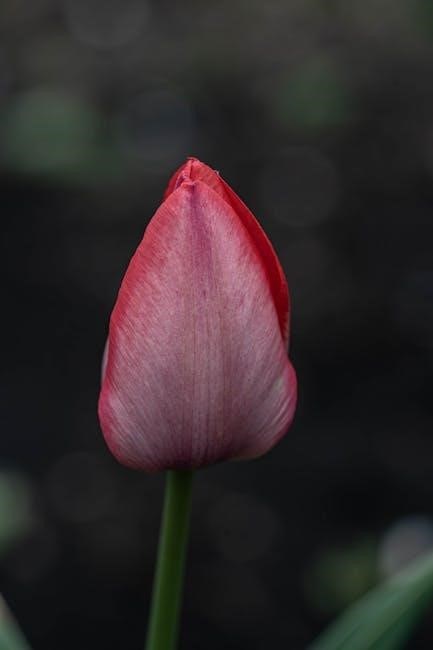Embark on a delightful journey into the art of paper folding with origami flowers! This accessible craft transforms simple sheets into elegant floral creations. Discover the joy of crafting beautiful, lasting blooms with our easy-to-follow instructions and downloadable PDF guides.

What is Origami?
Origami, originating from Japan, is the art of paper folding. It transforms flat sheets of paper into intricate sculptures through precise folds and creases. Learn the basics and create beautiful origami flowers with our PDF instructions!
Brief history and definition of origami
Origami, derived from the Japanese words “ori” (folding) and “kami” (paper), boasts a rich history dating back to the 6th century in Japan. Initially a practice reserved for the elite due to paper’s high cost, it gradually evolved into a popular art form. Today, origami is defined as the art of folding paper into decorative shapes and figures, emphasizing clean folds and geometric precision, often without the use of cuts or glue.
The appeal of origami flowers
Origami flowers hold a unique appeal, blending artistry with sustainability. Unlike real flowers that wither, origami blooms offer lasting beauty, making them perfect for gifts or decorations. The craft promotes mindfulness and precision, providing a calming creative outlet. Furthermore, origami flowers allow for personalized creations, with endless possibilities in color, paper type, and complexity, ensuring a unique and cherished final product.
Types of Origami Flowers
Explore the diverse world of origami flowers! From the classic rose to the serene lotus and elegant lily, discover a variety of beautiful designs. Each flower offers unique folding techniques and stunning visual results.
Origami Lotus Flower
The origami lotus flower, a symbol of purity and enlightenment, is a captivating model to create. Its symmetrical petals and elegant form make it a favorite among origami enthusiasts. Typically crafted from a single sheet of paper, the lotus involves precise folding to achieve its distinctive multi-layered appearance. Find free PDF instructions online for various lotus variations, ranging from simple to more intricate designs, suitable for different skill levels. The finished lotus makes a beautiful decoration or thoughtful gift.
Origami Lily Flower
The origami lily flower is a classic design celebrated for its graceful curves and realistic appearance. Often considered an easier project than the origami rose, the lily’s elegant simplicity makes it perfect for beginners. Online resources provide free downloadable PDF instructions for creating various lily styles. These instructions usually include step-by-step diagrams and folding guides. With a few simple folds, transform a square of paper into a beautiful representation of this iconic flower. It is a wonderful decorative piece or a thoughtful handmade gift.
Origami Rose
The origami rose stands as a symbol of beauty and complex artistry in the world of paper folding. Often regarded as one of the most challenging origami flowers, it requires patience and precision. Numerous online tutorials and downloadable PDF guides offer step-by-step instructions for various rose designs. Some designs involve simpler folds, while others incorporate intricate techniques for creating realistic petals and details. Despite the complexity, the reward is a stunning paper rose, a testament to your origami skills.

Materials Needed
To begin your origami flower journey, gather essential materials. The most vital is origami paper, available in various colors and thicknesses. Optional tools like bone folders can aid in crisp folds, but are not always necessary.
Selecting the right origami paper
Choosing the correct paper is crucial for successful origami flowers. Opt for thin, crisp paper specifically designed for origami, often called “kami.” This paper folds easily and holds its shape well. Avoid thick or flimsy paper, which can tear or create bulky folds. Experiment with different colors and patterns to add unique flair to your floral creations. Double-sided paper is ideal for models where both sides are visible.
Tools for origami (optional)
While origami primarily relies on your hands, certain tools can enhance the folding process. A bone folder helps create sharp, precise creases, especially with thicker paper. Tweezers can assist with manipulating small or intricate folds. A cutting mat and craft knife are useful for trimming paper to the exact size. A ruler ensures accurate measurements for complex designs. These tools are optional but can improve the quality and ease of your origami flower projects.
Finding Instructions and Tutorials
Unleash your creativity with a wealth of origami flower instructions and tutorials! Discover free PDF resources and online video guides to help you master the art of paper folding and create stunning floral designs.
Free PDF resources for origami flower instructions
Dive into the world of origami flowers with our curated collection of free PDF instructions! These resources offer step-by-step diagrams and written guidance for various flower designs, from simple blossoms to complex roses. Easily download and print these PDFs to have readily available instructions for your paper-folding projects. Explore different styles and difficulty levels to find the perfect flower to create.
Online video tutorials for visual learners
For those who prefer visual guidance, online video tutorials offer an engaging way to learn origami flower folding. These videos demonstrate each step clearly, making it easy to follow along and master the techniques. Explore various platforms like YouTube for a wide range of tutorials, catering to different skill levels and flower types. Watch, pause, and rewind as needed to perfect your origami skills and create stunning floral designs.

Basic Origami Folds to Know
Mastering fundamental origami folds is crucial for creating beautiful origami flowers. These basic techniques form the foundation for more complex designs, ensuring clean lines and precise shapes in your floral creations.
Mountain fold and valley fold
The mountain fold and valley fold are the cornerstones of origami. A mountain fold creates a raised ridge, resembling a mountain peak. Conversely, a valley fold forms an inward crease, like a valley. Mastering these folds is essential, as they dictate the structure and appearance of your origami flower. Practice these folds diligently using clear, printable PDF diagrams to ensure accuracy and crispness in your finished model. With consistent practice, these folds will become second nature.
Reverse fold and squash fold
As you progress in your origami journey, you’ll encounter more complex folds like the reverse and squash folds. A reverse fold involves folding a flap inside or outside the model, changing its direction. The squash fold requires opening a folded flap and flattening it into a diamond shape. These advanced techniques add dimension and detail to your origami flowers. Consult detailed instructions and diagrams in our accessible PDF resources.
Step-by-Step Instructions: Simple Origami Flower
Ready to create your first origami flower? Follow our detailed, step-by-step guide, complete with clear diagrams in an easily accessible PDF. Learn the fundamental folds and techniques to craft a beautiful paper bloom with ease.
Detailed guide with diagrams (link to PDF)
Unlock the secrets to crafting a stunning origami flower with our comprehensive PDF guide. This resource offers a detailed walkthrough, featuring step-by-step instructions accompanied by clear, easy-to-understand diagrams. Perfect for beginners, this guide will help you master the essential folds and techniques needed to create a beautiful and intricate paper flower. Download the PDF now and start your origami journey today!
Tips for achieving clean folds
To create crisp and professional-looking origami flowers, focus on precision. Use a hard, flat surface for folding. Crease each fold firmly with a bone folder or your fingernail. Accurate folds are key to a well-defined final product. Ensure your paper is perfectly aligned before each fold. This minimizes errors and enhances the overall aesthetic appeal of your origami flower, resulting in a more polished and satisfying creation.
Advanced Origami Flower Techniques
Ready to elevate your origami skills? Explore advanced techniques like modular origami, where multiple pieces combine to form intricate flowers. Experiment with wet-folding to achieve graceful, curved petals, adding a touch of realism to your paper blossoms.
Modular origami flowers
Dive into the captivating world of modular origami, where numerous identical units interlock to create stunning floral sculptures. These flowers showcase complex geometric beauty, offering a rewarding challenge for experienced folders. Mastering modular techniques opens doors to crafting intricate kusudama balls and multifaceted blossoms. Each module, precisely folded, contributes to the final form’s structural integrity and visual appeal. Explore the endless possibilities of modular origami flower designs.
Wet-folding for curved petals
Explore the art of wet-folding, a technique that introduces graceful curves and lifelike contours to your origami flowers. By lightly dampening the paper, you can mold and shape the petals with greater ease. This advanced method allows for rounded forms and subtle details, mimicking the delicate nature of real blossoms. Wet-folding requires patience and practice, but the resulting organic shapes elevate your origami creations to a new level of realism.
Tips for Displaying Origami Flowers
Showcase your origami flowers with flair! Create stunning bouquets by combining different flower types and colors. Use them as unique decorations for special occasions or add a touch of elegance to your home decor.
Creating bouquets and arrangements
Crafting origami flower bouquets and arrangements allows for a unique blend of creativity and artistry. Experiment with varying heights, colors, and flower types to achieve visually appealing compositions. Consider using floral wire or skewers to provide support and arrange the flowers as desired. Secure the stems with ribbon or twine for a polished look. Explore different vase styles or containers to complement your origami floral creations and enhance their overall aesthetic appeal.
Using origami flowers in decorations
Origami flowers provide a unique and charming touch to any decorative setting. Use them to adorn gift boxes, embellish greeting cards, or create eye-catching centerpieces. Incorporate them into wreaths, garlands, or mobiles for festive decorations. Attach them to hair accessories, clothing, or jewelry for a whimsical accent. Their lightweight nature makes them versatile for various applications. Experiment with different colors and sizes to match your desired aesthetic, transforming ordinary spaces into vibrant displays.

Preserving Origami Flowers
Protect your delicate origami flowers from wear and tear to maintain their beauty. Explore methods to enhance durability and longevity, ensuring your paper creations remain vibrant and intact for years to come.
Using sealants and resins
Applying sealants and resins is a great way to preserve origami flowers and give them a longer life. These protective coatings add durability and prevent damage from moisture and handling. Choose a sealant that dries clear and does not yellow over time. Consider using a brush-on or spray-on application for even coverage. Experiment with different finishes, such as glossy or matte, to achieve the desired aesthetic.
Choosing durable paper
Selecting the right paper is crucial for long-lasting origami flowers. Opt for thicker, high-quality paper that can withstand repeated folding and handling without tearing. Look for paper specifically designed for origami or cardstock with a smooth texture. Consider using specialty papers like Washi or Lokta for added strength and visual appeal. Experiment with different weights and finishes to find the perfect balance of durability and aesthetics for your floral creations.
Troubleshooting Common Problems
Even experienced folders encounter issues. This section addresses common origami flower problems, offering practical solutions. We’ll cover paper tearing, instruction comprehension, and achieving clean folds. Overcome these challenges and elevate your origami skills with ease.
Paper tearing during folding
Paper tearing is a common frustration, especially with intricate folds. Selecting the right paper is crucial; thinner origami paper is generally more pliable and less prone to tearing. Ensure your folds are precise but gentle, avoiding excessive force. Pre-creasing can also weaken the paper, so fold deliberately. If tearing persists, consider using slightly damp paper for increased flexibility or opting for a sturdier paper type designed for wet-folding techniques. Experiment with different papers to find the best fit for your chosen origami flower model.
Difficulty understanding instructions
Origami instructions can sometimes be challenging to decipher. If you’re struggling, try breaking down each step into smaller, more manageable actions; Supplement written instructions with video tutorials, which offer a visual demonstration of each fold. Pay close attention to the direction and precision of each fold, and don’t hesitate to pause and rewind as needed. Seek out instructions designed for beginners, and practice basic folds before tackling more complex models. Join an online origami community to ask questions and receive guidance from experienced folders.
